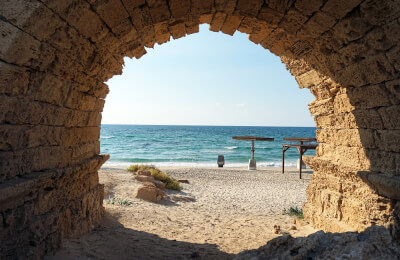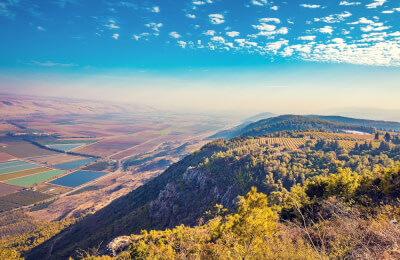
513. Flowering cyclamen Promotion

180. Uncharted Carmel Promotion

143. Israel in faces Promotion
We also found excursions from other cities that are close to your departure city
Other excursions that also deserve your attention
to Mount Carmel: A Symbol of Natural Beauty and Cultural Heritage
Mount Carmel, one of the most iconic landmarks in Israel, is a coastal mountain range in the north of the country known for its scenic beauty, rich history, and biodiversity. Rising above the city of Haifa, Mount Carmel has been a symbol of fertility and beauty throughout history and remains a place of great significance to this day.
Natural Splendor of Mount Carmel
The Carmel range, stretching from the Mediterranean Sea towards the southeast, forms a green backbone in the otherwise arid region. It's renowned for its lush forests, a rarity in the Middle East, which are mainly composed of pine, eucalyptus, and oak trees. The range is also home to the Carmel National Park, Israel's largest national park, which is often referred to as ""Little Switzerland"" due to its greenery and unique climate.
Historical Significance of Mount Carmel
Mount Carmel holds a deep historical and spiritual significance. It has been inhabited by humans since prehistoric times, with evidence of human activity dating back to over 600,000 years ago. One of the most remarkable findings in the area is the Skhul Cave, where remains of early Homo sapiens have been discovered. In the Hebrew Bible, Mount Carmel is frequently mentioned, most notably as the site of the Prophet Elijah's challenge against the prophets of Baal. This biblical account has made Mount Carmel a pilgrimage site for various religions, including Judaism, Christianity, and Islam.
Cultural and Spiritual Heritage
Throughout the centuries, Mount Carmel has been a place of religious contemplation and solitude. The Carmelite Order, a Catholic religious order, was founded on the mountain in the 12th century and still maintains a presence there with the Stella Maris Monastery, which is open to visitors and provides breathtaking views of the Mediterranean Sea.
Mount Carmel’s Biodiversity and Conservation Efforts
The UNESCO has recognized parts of Mount Carmel as a biosphere reserve due to its rich flora and fauna. Over 670 plant species, 18 of which are endemic to Mount Carmel, make the region an important location for botanical research and conservation. It's also a sanctuary for numerous wildlife species, including the Persian fallow deer, which has been successfully reintroduced into the wild here after being considered extinct.
The Caves of Mount Carmel: Windows to Prehistory
The caves of Mount Carmel have been the focus of archaeological interest for many years. The Nahal Me'arot/Wadi el-Mughara Caves, a UNESCO World Heritage Site, have provided insight into the prehistoric cultures of the Levant. The caves have revealed evidence of burial customs, early stone architecture, and the transition from a hunter-gatherer lifestyle to agriculture and sedentism.
Mount Carmel in Literature and Symbolism
Mount Carmel has long served as a symbol of beauty and fertility, often mentioned in poetry and scriptures for its prominence and lushness. Its name is even used as a standard metaphor for beauty in the Song of Solomon, and it continues to be a muse for poets and artists to this day.
The Druze Community of Mount Carmel
Mount Carmel is also home to the Druze, a unique religious and ethnic minority in Israel. The Druze village of Daliyat al-Karmel offers an insight into this closed-off culture and is famous for its colorful market, traditional crafts, and welcoming inhabitants.
Recreational Activities: Hiking and Exploring Mount Carmel
The mountain range is crisscrossed with trails that invite hikers of all levels to explore the area’s natural beauty. Among the well-known trails is the 'Little Switzerland' path, which provides an opportunity to experience the Carmel's landscapes and panoramic vistas.
Mount Carmel’s Modern Presence: Haifa’s University and Technological Hub
At the heart of Mount Carmel lies the city of Haifa, Israel's third-largest city. The University of Haifa, situated on the mountain, is a prominent academic institution known for its diverse student body and research contributions. Haifa is also an important center for high-tech industry, earning the area the nickname ""Silicon Wadi.""
Interesting Facts About Mount Carmel
- The name 'Carmel' is derived from the Hebrew word 'Kerem-El,' meaning 'God’s Vineyard,' which is a testament to the region's lush vegetation. - Mount Carmel is occasionally blanketed with wildflowers in spring, creating a spectacular display of color. - The mountain range has several Druze holy sites, which are visited by followers from around the world.
Conservation and the Future of Mount Carmel
The beauty and biodiversity of Mount Carmel have led to concerted efforts to preserve this unique environment. Conservation programs aim not only to protect the natural habitats but also to educate the public on the importance of maintaining the delicate balance between development and nature conservation.
Conclusion: Mount Carmel's Enduring Legacy
Mount Carmel remains an enduring symbol of natural beauty, historical depth, and cultural diversity in Israel. Its verdant slopes and rich heritage continue to inspire, attract visitors, and serve as a living example of the intricate link between humans and their environment. Whether it's through the spiritual quest of pilgrims, the intellectual pursuit of scholars, or the enjoyment of nature lovers, Mount Carmel offers a multifaceted experience that is both enriching and enchanting. It stands as a testament to Israel’s complex layers of history, faith, and natural splendor, and it remains a site where past and present, nature and civilization, beautifully converge.







